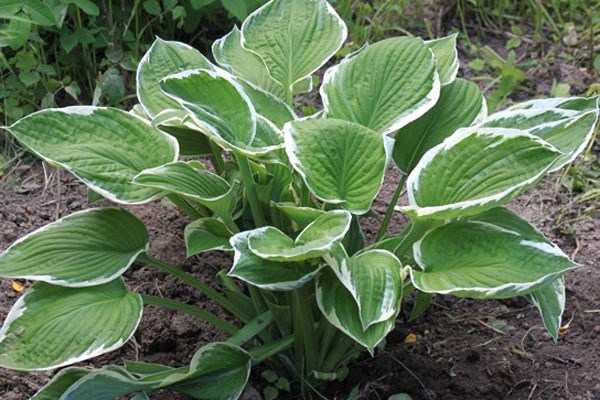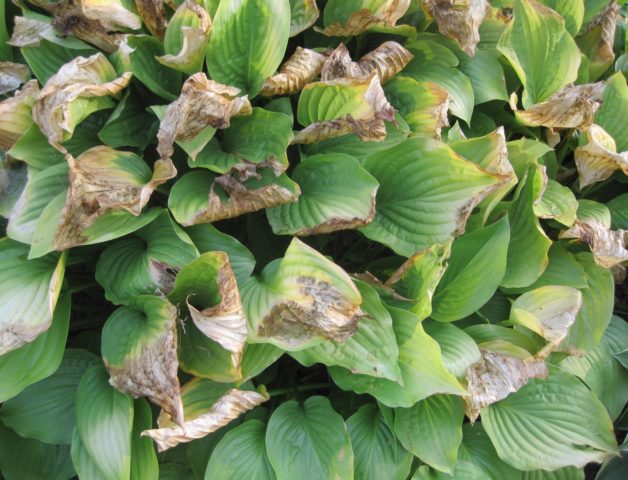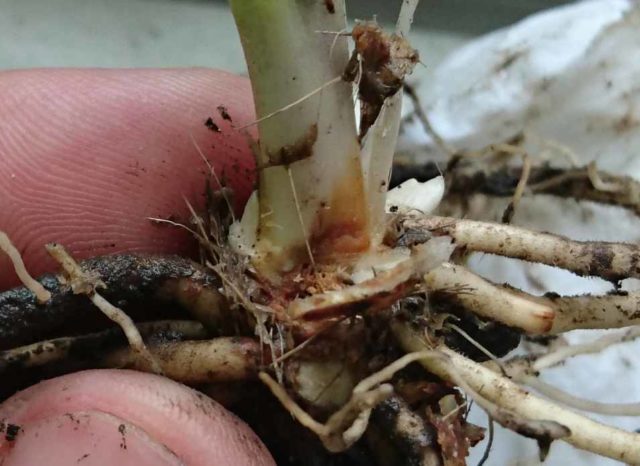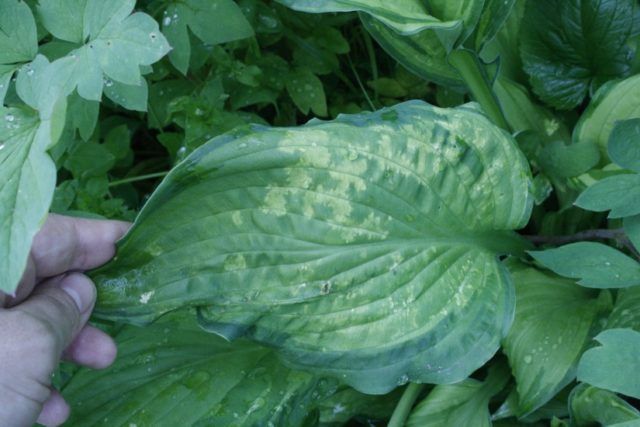Content
It is interesting to know that, in fact, the hosta can be planted in the sun, contrary to popular belief that the "queen of the shadow" does not tolerate bright light. Most of the species of this plant are really shade-loving, and their natural habitat is dense twilight under the crowns of trees in a moist forest, a cool shore of a reservoir, an overgrown ravine gap or a mountainside. However, there are also such functions that look great and develop under the rays of the sun - in an open area, in the middle of a meadow, in a river floodplain. First of all, this is the plantain hosta and its hybrids, but currently varieties have been bred on the basis of other common species, among which the advantages are the possibility of planting in illuminated places. If you take into account the other preferences of the hosta, which is not afraid of the sun, and organize proper care for it, you can ensure that these spreading decorative perennials will grow successfully in all corners of the garden.
Can the hosta be planted in the sun
Of course, not every host tolerates landing in the bright sun well. However, if you choose a specimen of a suitable variety and create favorable conditions for it in a lighted area of the garden, then the plant may well feel comfortable.

To date, many hosta varieties have been bred that feel good in the sun.
When deciding which host to land on the sunny side, you need to take into account the following factors:
- Morphological features of the variety. If the hosta has thick, glossy leaves, then its resistance to the rays of the sun is definitely higher than that of specimens with thin and matte plates. The smooth, shiny surface reflects the rays well, and due to its dense structure, the green mass retains moisture better.
- Plant coloring. Hostas with yellow and golden leaves are best tolerated by the sun, even if only the middle or edge is painted in this color. Varieties with white stripes and spots tolerate an excess of light somewhat worse. And, finally, blue-blue hosts with a waxy bloom on the leaf surface are extremely shade-loving. The sun melts this protective layer, which protects the plant from burns, age spots, fungal diseases, excessive moisture evaporation. As a result, the bush grows old and dries prematurely.
- Climatic conditions of the region. If summer comes early, and is usually dry and hot, then it will be much more difficult for the host to adapt in a sunny area than in conditions when this time of the year is usually wet and cool, with many cloudy days. Correct agricultural technology will help to correct the conditions set by nature: the organization of timely watering and shading of the bushes at noon, planting them in the openwork shade of tall bushes and trees.
The color of various hosta varieties growing in the light can sometimes deviate quite significantly from the varietal standard:
- greens turn pale;
- blues take on green tints;
- yellow ones either become brighter (in lutescent varieties), or turn green (in viridescent ones).
In any case, it is impossible to predict exactly how a host of a particular variety will look and feel, growing in the sun. This is usually found out empirically by planting a bush in appropriate conditions and observing it.
The best hosta varieties for sunny spots
The most crucial stage is to decide which function is to be placed on the illuminated area. Below are descriptions and photos of hosta varieties most suitable for sunny places.
Sun Power
Classic medium-large (up to 60 cm in height) hosta with domed bushes and spectacular pale lavender flowers. Its leaves are elliptical with a pointed end. Veins are clearly visible on their wavy, slightly corrugated surface. The color of young Sun Power foliage is greenish.
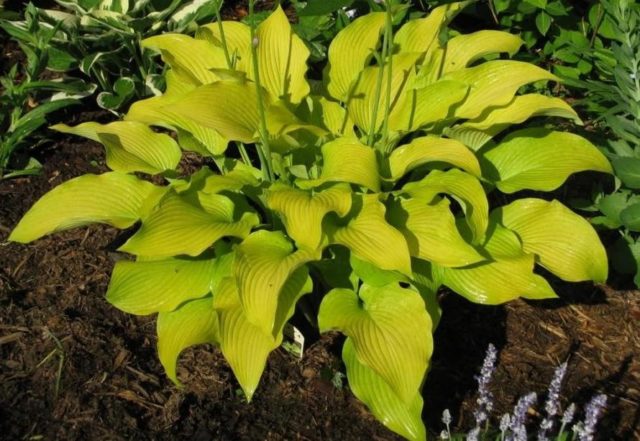
With age, the color turns into a rich golden color if the hosta grows in the sun, or becomes close to the color of a lime in partial shade
Blue mouse ears
"Blue Mouse Ears" is a popular mini-host about 25 cm high. Its silvery-blue leaves with a slightly wavy edge resemble hearts and are invulnerable to slugs due to their dense texture. Winters well. It grows slowly, is actively used as a ground cover crop or for planting in containers.

Hosta Blue Mouse Ears prefers partial shade, while great for the morning sun
June Fever
"June fever" is a short (35-45 cm) compact host with small but dense drop-shaped leaves. Their color is bright yellow with a thin emerald border along the edge. When planted in the sun, the color of June Fever leaves becomes brighter, but almost loses its contrast.
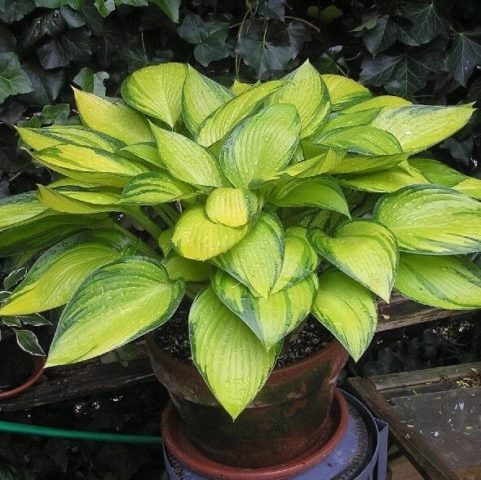
June Fever blooms in the second half of summer with light purple flowers
Devon green
Hosta is medium in size (up to 45 cm) with glossy dark green hard leaves, on the surface of which veins are clearly visible, and lavender flowers. The shape of the leaf blade is broadly oval with a pointed end. The bush is dense, dense, the leaves overlap.
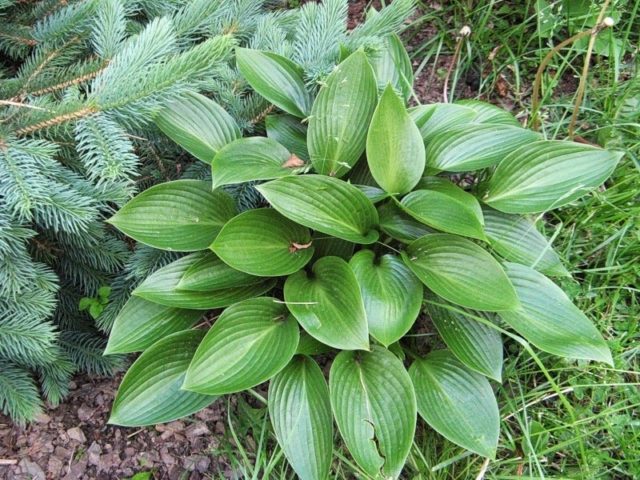
Hosta Devon Green is a versatile variety that grows well in both sun and shade
Fire Maiden
"Beautiful Virgo" is a very decorative hosta of medium size (the bush reaches 20-30 cm). The edges of its wavy, slightly concave gray-green leaves are bordered with creamy white or yellowish contrasting "feathers". Fair Maiden grows slowly, does not tolerate heavy soils. Can be planted both in the sun and in partial shade.
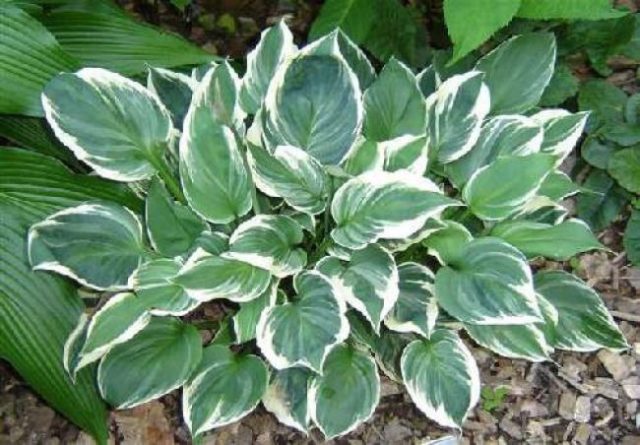
In the second half of the summer, the Hosta Fair Maiden is decorated with large white lavender flowers.
Empress wu
"Empress Wu" is recognized as the tallest decorative host in the world. The height of its bush reaches 1.2-1.8 m, and the width of a massive dense sheet with a waffle surface structure is about 40 cm. The color of the leaf plate is dark green, in spring it is covered with a bluish bloom. The bush grows very quickly, provided sufficient soil moisture is maintained and regular feeding. Large lavender flowers on tall stems appear in mid-July.
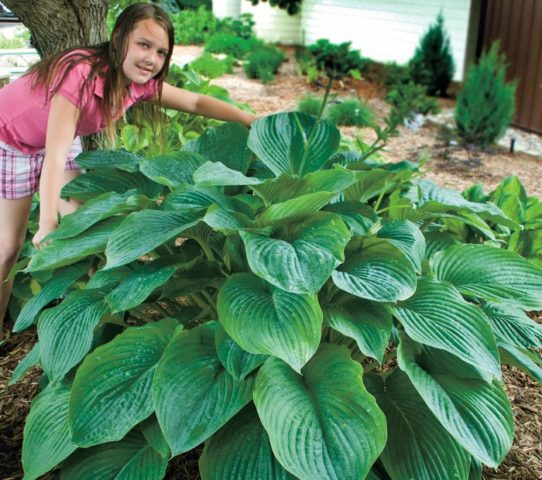
Empress Wu grows in sun and shade
Blue Ivory
A medium-sized hybrid Blue Ivory (up to 45 cm) capable of growing into a wide bush up to 1.2 m in diameter. The central part of the dense, heart-shaped leaf, slightly elongated to the tip, is painted in a bluish-blue color, while the wide border along its edge is creamy white with a yellowish tinge. The flowers are delicate, light blue in color. Grows well near water bodies.
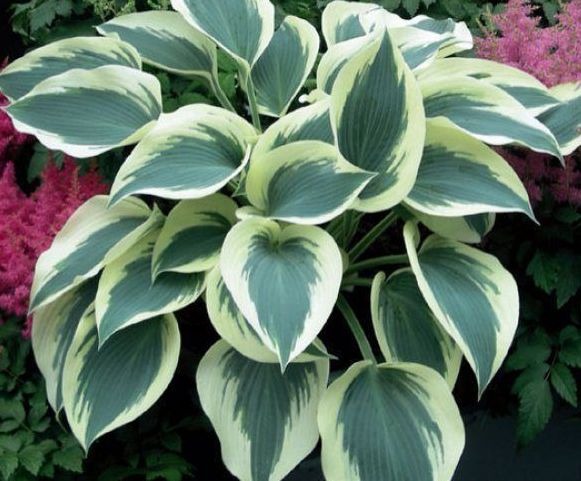
Hosta Blue Ivory prefers partial shade, but can also be in the sun, provided it is shaded at noon
Francee
The lush, fast-growing "France" hosta bush has the shape of a hemisphere and can be up to 70 cm in height. Its leaves are dense, juicy, dark green, with a narrow white uneven border along the edge. When planted in the shade, the color of the greenery is richer, in the sun it is lighter.
Flowers of the France variety are large, funnel-shaped, lavender, with a delicate pleasant aroma.
Christmas Candy
"Christmas Candy" can also be attributed to the sun-loving hosta varieties. The upright bush can grow up to 45 cm. Christmas Candy leaves are oval with a pointed end, dense, large. The central part of them is painted in ivory and retains this tone throughout the season. Uneven wide border around the edge is dark green.

Ideal for lighting the hosta landing site: in the morning - the sun, the rest of the time there is a light shade
Guacamole
The broad leaves of this large (up to 60 cm in height) hosta are ovoid, glossy, and well-visible venation. The color of the plate at the beginning of the season is close to the shade of lime or green apple, over time it changes towards golden.
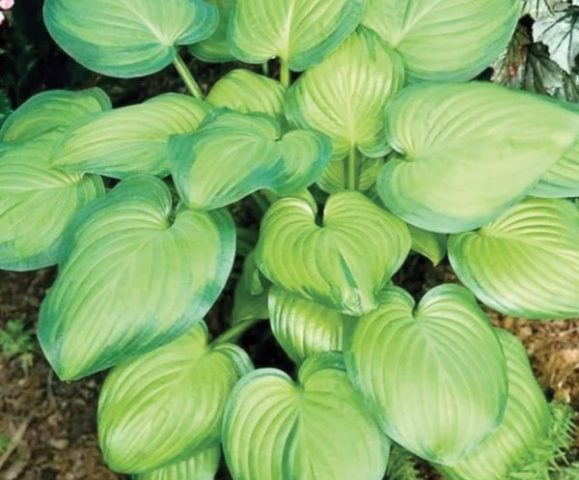
The dark green border of Guacamole along the edge of the leaf is hardly noticeable and appears only when the hosta is in the sun for several hours throughout the day.
Sow Sweet
The compact hosta of medium size (40-50 cm) is characterized by slightly crinkled, bright glossy green leaves with a wide, irregular yellow-creamy border, which by the end of the season has time to fade to whiteness. So Sweet grows quickly, tolerates light partial shade and full sun.
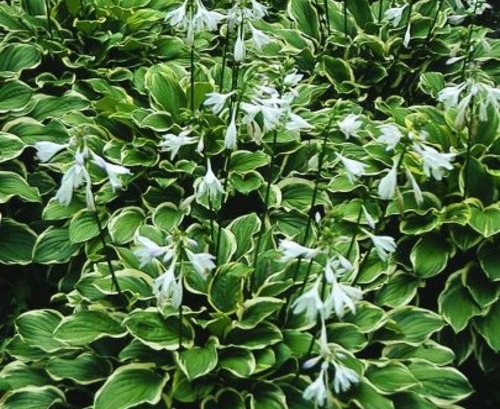
So Sweet flowers are fragrant, white, with a slight lavender tint
Irish luck
The luck of the Irishman is a very unusual, large hosta about 60-70 cm high, always recognizable by the characteristic glossy sheen of solid, dark green leaves with a wavy edge. Leaf blades with pronounced veins, slightly elongated, on long petioles. The bush grows rapidly.
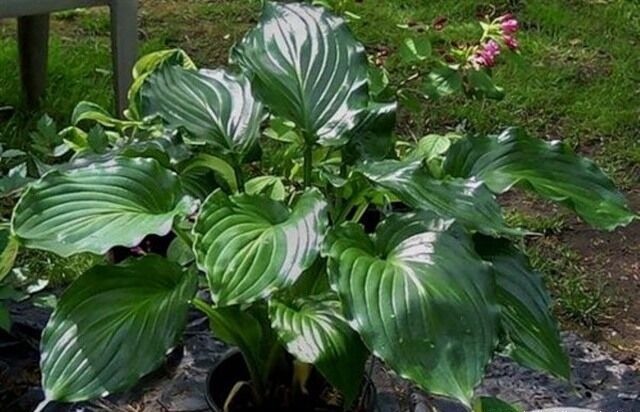
Irish Luck is shade-loving, but also tolerates the sun well
Captain Kirk
The variety is of medium height (60 cm) with fleshy, dense rounded leaves. In the middle, each of them is painted in a bright light green-yellow color, while a wide border of a rich green hue is noticeable along the edge. Captain Kirk grows well in moist, acidic soil.
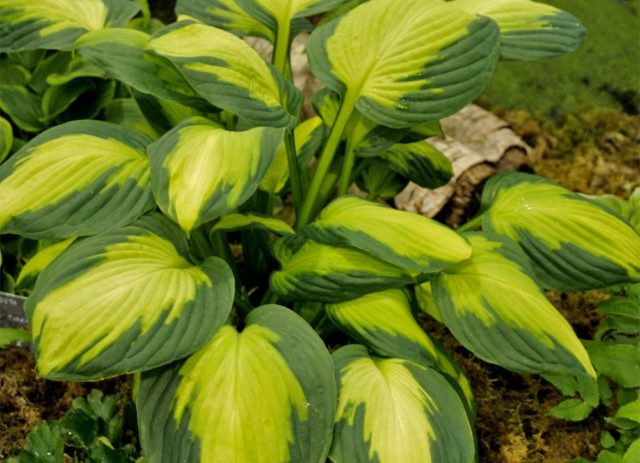
Captain Kirk blooms by the beginning of August in large pink-lilac flowers
Lemon delight
Miniature (up to 20 cm) fast-growing hosta with lanceolate thin leaves with a wavy edge, distinguished by a green center and a narrow golden border. It blooms with bright lilac buds, beautifully and very profusely, sometimes even twice during the season.
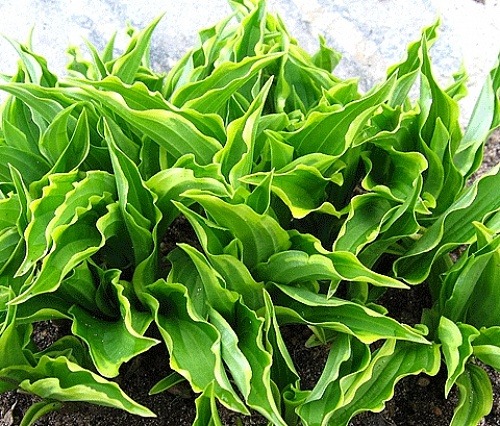
Lemon Delight prefers sun in the morning and light shade the rest of the day.
Sam and Substance
Among the yellow-leaved hosta varieties that grow well in the sun, this beauty is considered one of the largest and most spectacular. Its height is about 90 cm, and the width of the leaf plate reaches 38 cm. The adult Sum and Substance bush is dome-shaped and grows rapidly. Its wide leaves are curved like a "cup", they are dense, pointed and moderately corrugated. The color of the central part of the leaf is light green, smoothly turning into yellow at the edges.
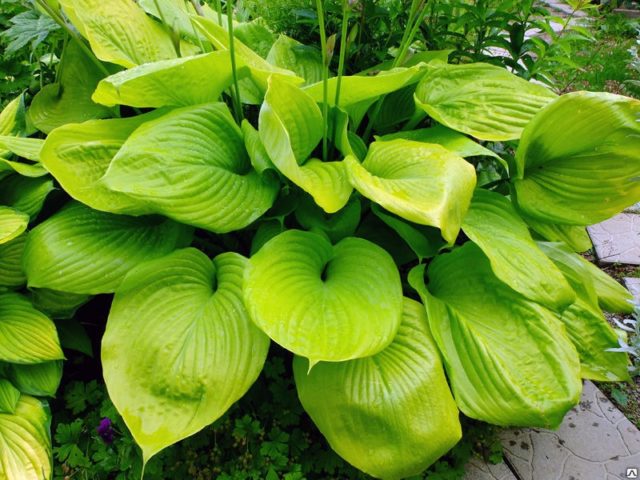
In the sun, the yellow pigmentation of Sam and Substance is enhanced
Aureomarginate
Hosta variety Fortchuna, which grows up to 50 cm. It is characterized by wide oval leaves resembling hearts of rich green color with a thin olive border along the edge. Aureomarginata does well in the sun, but the color becomes somewhat paler. It grows quickly.

Aureomarginata has excellent frost resistance
Striptease
Striptease owes its name to a narrow white strip running through the yellowish center of the leaf and its wide dark green edges. The plates are dense, with a low sheen, slightly wavy.
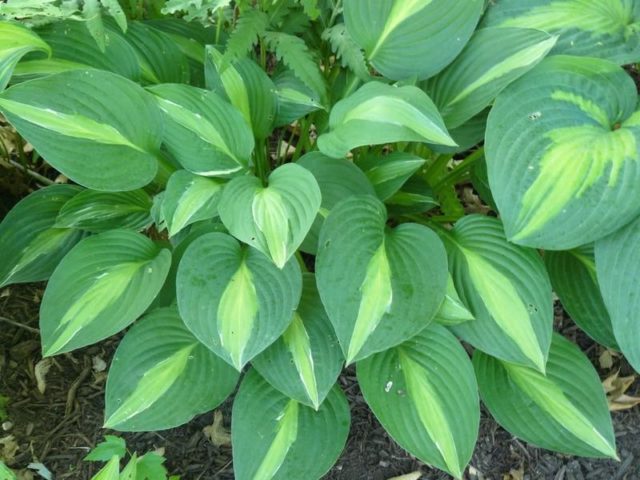
Planting the variety in the sun is possible, but the most strikingly unusual color of this hosta will manifest itself in partial shade.
White Feather
Compact plant up to 30 cm tall with lanceolate glossy, creamy white leaves.During the season, green stripes gradually appear on them, filling almost the entire plate by the end of summer. White feather variety is frost resistant. It is immune to many diseases.
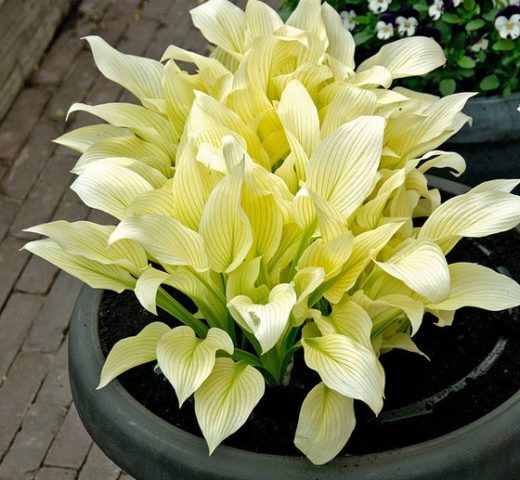
White Feather does not need pruning and grows rapidly
Tattoo
The bright leaves of this mini-hosta (bush height up to 15 cm), golden-green with a green edge, seem to be decorated with a "tattoo" in the form of a maple leaf. In adult plants, the pattern is more noticeable, and the plates look weakly compressed. The bush grows slowly.
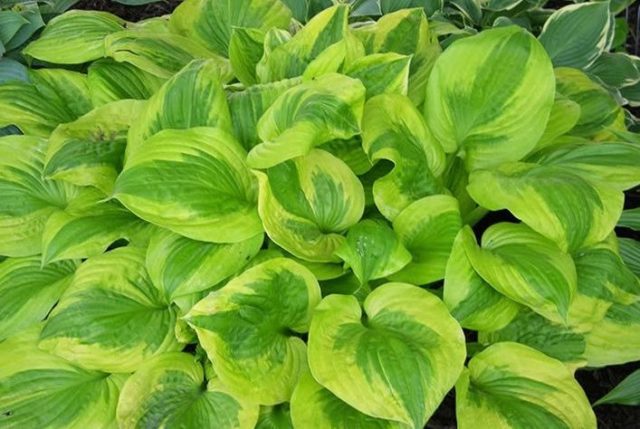
Tattoo prefers partial shade, although it can also tolerate the sun in the morning.
Features of caring for sun-loving hosts
Caring for sun-growing hosta varieties is about creating the right conditions for these plants to stay strong and healthy, while showing their varietal characteristics in the best possible way. Regardless of where these plants are planted, they require:
- sufficiently moist nutrient soil;
- regular loosening and weeding;
- 2-3 additional fertilizing with complex fertilizers during the season;
- protection against diseases and pests.
At the same time, some elements of care should be taken with special attention if the host is supposed to grow in the sun:
- Planting in the soil with a suitable composition. The soil should be light, loose and moist, ideally a loam with a neutral or slightly acidic reaction. To increase the nutritional value, it is advisable to fill it in advance with organic matter (leafy soil, compost, rotted manure). Prerequisites are good aeration and drainage.
- Properly organized watering. The leaves of a hosta growing in the sun actively evaporate water. In this regard, they must be watered abundantly as the soil dries up, moistening the ground by about 10 cm in depth. It is advisable to do this in the morning or in the evening, carefully making sure that drops do not fall on the surface of the leaves, otherwise the daytime sun can burn them badly.
- Mulching the soil at the roots with crushed tree bark, wood chips, fine gravel. This will help to further retain moisture.
- Shading at noon. This measure is especially relevant if the high air temperature (more than + 35 ° C), along with the bright sun, lasts for a long time. You can arrange an artificial cover or canopy for the hosts, or create an openwork shade by planting tall companion plants on the south side.
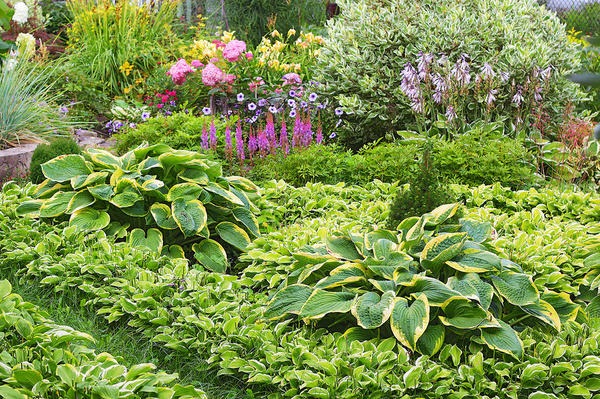
Hosta will be an excellent decoration for a sunny garden area with the right choice of variety and proper care.
Diseases and pests
Certain diseases can cause significant harm to the health and beauty of the hosta growing in the sun. Most often, gardeners are faced with such troubles:
- Sunburn... The leaves lose their turgor and wither, discolored spots appear on their surface, the tissue in these places quickly dries up and crumbles.
Obviously, an excess of the sun is destructive for the hosta, so it is advisable to organize a shelter for her from the scorching rays or transplant it into an openwork shade.
- Root collar rot... The plant must be dug up, carefully cleaned the roots from the ground, cut off the damaged areas with a sterile knife and treated with a fungicide. After that, it is necessary to transplant the host to a new place, in a well-drained light soil.
The disease manifests itself in discoloration and rapid death of foliage, while the plates dry out or become wet and sticky
- Defeat by the HVX virus... It can appear 2-3 years after plant infection. At an early stage, an unnatural, mottled color of the leaves is characteristic - the appearance of streaks, stripes, seals, "mosaics". The disease cannot be treated, therefore it is important to prevent infection of healthy plants: disinfect equipment and tools before transplanting and pruning, keeping purchased specimens in quarantine before planting next to those that are already growing on the site; purchase a host that strictly matches the description of the variety.
In the late stage of the virus, root decay develops, and the hosta dies
The most common insects that harm the host are slugs and snails. They gnaw multiple holes with ragged edges in the leaf blades, and leave traces on their surface. Chemical preparations ("Slime-eater", "Thunderstorm"), as well as mulching the soil under the plants with broken shells, pine needles, and wood ash will help to cope with them. Gives results and manual collection of pests.
Conclusion
When choosing which hosta can be planted in the sun, you should correctly determine its variety, taking into account such features as the thickness of the leaves, their color and surface texture. It is also important to take into account the specifics of the climate in the region where the site is located. If you prepare suitable soil for the plant, provide it with sufficient watering, regularly loosen and mulch the soil under the roots, and also organize shading in the middle of the day, then the sun's rays will most likely not prevent the hosta bush from being a luxurious and beautiful flower bed decoration.
